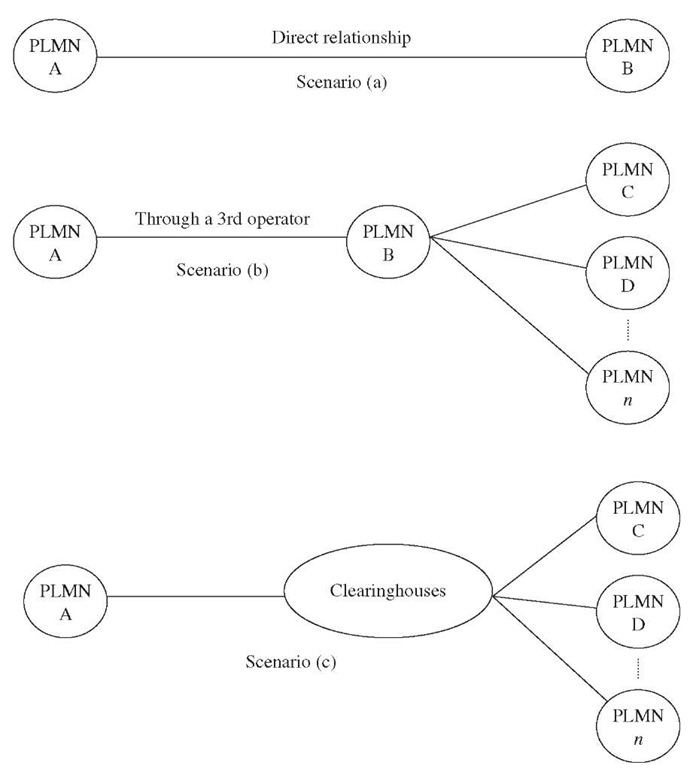Wireless networks are a heterogeneous group, being based on different technologies and standards. Each operator needs to partner with many networks (typically 200 or more) to meet its subscribers’ roaming needs. This means that wireless service providers need to manage multiple relationships, interconnect globally, and exchange data with multiple formats. On the commercial side, they need to manage complicated financial relationships with varying laws and regulations in different parts of the world. Figure 11-4 shows the three possible relationship scenarios between operators.
In scenario (a), the operators have a direct relationship. This is a preferred option for the operators in neighboring countries where heavy roaming traffic is expected.
Figure 11- 4 Roaming relationship scenarios.
It is also used between operators having the same management. Operators offering national roaming also commonly deploy this scenario. Although wireless service providers do have a choice to connect directly to all their partners, it is obvious that a point-to-point relationship with each roaming partner is not feasible and is cost-prohibitive.
Scenario (b), often called a piggyback relationship, is used between operators that are members of the same alliance or managed by the same group.
In scenario (c), an independent clearinghouse is used. Clearinghouses play a crucial role in making a global roaming footprint a reality. The primary aim of clearinghouses is to support wireless service providers in managing their global roaming operations. For new network operators, the clearinghouse helps them to speed up market entry. In general, clearinghouses offer the following services or subset of services:
■ Roaming agreement broker. The clearinghouse takes full responsibility for negotiation, preparation, and documentation of a roaming agreement on behalf of a PLMN.
■ Roaming partner management. The clearinghouse acts as a single point of contact for managing multiple roaming partners.
■ Facilitation of interstandard roaming. This includes, for example, management of different settlement and billing formats, signaling standards, switch incompatibilities, and proprietary extensions and of other technology issues.
■ Data clearing and settlement. The clearinghouse provides a centralized process for the exchange of TAP/CIBER data, monthly financial settlement, electronic data delivery, management of IOT and currency, etc.
■ TAP conversion. To support industry needs, GSMA releases several TAP version releases every year. Most recently, it has decided to release two versions annually. This means that wireless service providers need to upgrade their billing systems to support new TAP releases all the time. The frequent billing system upgrades are not desirable, considering roll-out time and cost. Many service providers prefer to maintain a certain TAP version and outsource conversion to the latest TAP version to clearinghouses.
■ Customer care and business intelligence. The clearinghouse acts as source for roaming activity. For example, with the data they have, they can easily build roamers’ profiles, e.g., where they come from, how long they stay, and what services they use. This is extremely useful information for customer care and marketing.
■ Fraud management. The clearinghouse helps operators in detecting frauds early. Fraud types such as cloning and subscription can be handled effectively. The TAP3 specification calls for high-usage reports to be sent to HPMN to combat roaming fraud. The VPMN can implement a fraud management system on its own or outsource this function to clearinghouses to meet its obligation.
In addition, some clearinghouses also provide CCS7 and IP connection paths between partners.

